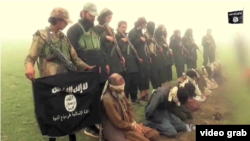The Obama administration announced last month that the United States will deploy Special Operations Forces to northern Syria to support Kurdish and Arab forces fighting Islamic State (IS) militants, which prompted debate on the U.S. presidential campaign trail.
On prominent Republican Presidential hopeful said that while IS extremists must be confronted, he would not favor a massive U.S. military deployment to fight the group directly.
Another presidential hopeful, Democratic Senator Bernie Sanders, said he fears a deployment of up to 50 troops in Syria could presage a larger commitment. His primary Democratic campaign opponent, former Secretary of State Hillary Clinton, issued a statement saying she “sees merit” in a limited deployment to Syria, but opposes a larger ground war in the Middle East.
The White House stressed that a train-and-assist role for Special Forces sent to Syria is not a departure from the commitment not to put boots on the ground.
According David Des Roches, associate professor at the National Defense University, while "boots on the ground" refers to conventional ground combat operations, the administration intends to continue guiding local fighters in their efforts against IS militants, repeating raids like the one to free Iraqi fighters and hostages that killed one U.S. Special Forces troop.
“The administration is walking a very fine line; they do not want to have the sort of commitment or presence in Syria that we have in Afghanistan or we had in Iraq,” Des Roches said. “But at the same time, they realize that the strategy that we have been pursuing is not likely to produce the results we want.”
He calls the new strategy a departure from focusing U.S. assistance on the so-called moderate Syrian opposition that was fighting President Bashar al-Assad, not IS.
“The U.S. is going to arm some people that in the past we might have considered to be not desirable allies, whether they are too extreme or there was some sort of problems with them," he said. " We're lowering our standards in favor of more combat effectiveness against [IS].”
That could eliminate a contradiction in the U.S. policy in Syria, according to Faysal Itani, Rafik Hariri Center fellow.
“The train-and-equip program was hampered from the start by vetting that required participants to fight ISIS only, and not Assad," he said. "The United States has recognized this absurdity and sending U.S. forces in is a rather elegant solution, since this avoids the Assad problem.”
Adequate intervention or Band-Aid?
Some experts argue that although the new strategy is not adequately comprehensive, it has some merits.
“It is a step in the right direction, because the Special Forces group can begin to establish better contact with various opposition forces, and do a better job of command and control and tactical air control,” said Michael O’Hanlon, a national security and defense policy analyst with the Washington-based Brookings Institution.
U.S. Secretary of Defense Ash Carter said the U.S. strategy against IS will include more airstrikes and possibly ground assaults.
Experts like Ambassador Frederec Hof, a former Obama administration special adviser for the transition in Syria, offered a mixed assessment.
“Deploying a handful of U.S. Special Operations forces to Syria will not change the situation significantly," he said. "It is a Band-Aid of sorts, although a potentially useful one.”
Ambassador Hof said President Barack Obama's objective of degrading and destroying IS is hampered in both Syria and Iraq by the absence of sufficient ground forces that are capable of seizing and holding significant territory with the backing of coalition air support.
“These special operators can certainly help existing resistance elements," he said. "By putting some 'skin in the game' on the ground in Syria, Washington may be able to make a credible pitch to regional powers to provide the ground combat components that can sweep IS from Syria, thereby tilting the fight in Iraq in a favorable direction."
Can it Work?
The U.S. already dropped ammunition and equipment to support Kurdish and Arab forces fighting IS militants in northern Syria, allowing the fighters to retake about 200 square kilometers (310 square miles).
But Michael O’Hanlon argues it is too early to draw conclusions about the new strategy.
“I think if the strategy’s goal remains to defeat [IS] and ultimately to put pressure on Assad to negotiate a new government, then so far we do not have a reason to be particularly sanguine about these outcomes," he said. "It is good news, but should not be viewed as a proof of the new strategy.”








